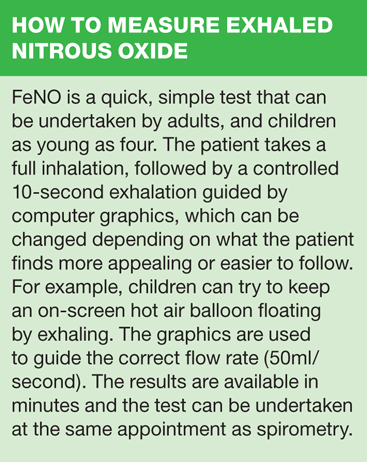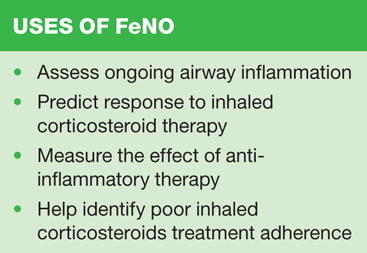Ten-second test in the diagnosis and management of asthma
Carol Stonham
Carol Stonham
RGN MSc Queens Nurse,
Senior Nurse, Minchinhampton Surgery, Stroud, Gloucestershire
Chair of the nurse committee of the
Primary Care Respiratory Society UK
NICE has recommended the use of 'fraction of exhaled nitrous oxide' testing as an additional tool in the identification of asthma when the diagnosis is unclear from the patient's symptoms or history — but what is the evidence for this technique?
Asthma is one of the most common chronic conditions encountered in primary care. In the UK, 5.4m people are estimated to have asthma, the third highest prevalence in the world. Asthma is the most common long-term medical condition and one in 11 children has it.1
Despite its prevalence, however, asthma remains one of the most difficult conditions to diagnose.2,3 While it is not yet widely implemented, fraction of exhaled nitric oxide (FeNO) has emerged in recent years as a useful tool in both the diagnosis and management of asthma.
Recent NICE guidance4 advocates nitric oxide testing as an option in diagnosing suspected cases of asthma along with other tests recommended by the British Guideline on the Management of Asthma.
Nitric oxide testing is also recommended as an option to support the management of asthma in children and adults who still have symptoms despite being treated with inhaled corticosteroids.
The recommendations state that measurement of exhaled nitric oxide, used alongside other diagnostic options, may also help clinicians and patients to find the most appropriate medication earlier and manage their symptoms better. This could, in turn, avoid admissions to hospital caused by asthma attacks and improve patient experience.
The use of FeNO testing in medical practice has a relatively short history. Up until the 1980s, nitric oxide was thought only to play a role in the detrimental effects of air pollution on the respiratory effect, but in 1991 nitric oxide was detected in exhaled breath samples Karolinska Institute in Sweden were the first to report increased FeNO levels in asthmatics.5
DIAGNOSIS
The British Thoracic Society (BTS) and Scottish Intercollegiate Guidelines Network (SIGN) guideline currently recommends initial diagnosis of asthma based on detailed history taking, a careful assessment of symptoms and measurement of airflow obstruction.6 These steps may be followed with trials of treatments such as inhaled corticosteroids where a patient is deemed to have an increased risk of asthma.
However, diagnosing and managing asthma using a patient's history and symptoms can be difficult because some symptoms related to asthma are shared with other respiratory conditions.
Being able to identify inflammation of the airways through FeNO testing offers another tool to assist in the accurate diagnosis of asthma.
Announcing the new guidance for the NHS, Professor Carole Longson, NICE health technology evaluation centre director, described diagnosing asthma as an often very complicated and lengthy process.
She said using devices to measure FeNO could provide additional information for clinicians about people who, following clinical examination, are considered to have an intermediate probability of having asthma. The NICE guidelines recommend using FeNO testing in combination with other diagnostic options.
Although it is not yet widely implemented, research to date has shown FeNO to be a useful biomarker for the assessment of airway inflammation, both in patients presenting with undiagnosed respiratory symptoms and in those with established airway disease.7
INHALED CORTICOSTEROID TREATMENT
Not only has FeNO testing been found to be useful in the diagnosis of asthma, but also in helping clinicians to decide whether inhaled corticosteroid treatment is likely to be effective and in guiding dosage decisions. FeNO is a surrogate marker of eosinophilic airway inflammation and a good predictor of corticosteroid response.
One of the UK's leading primary care respiratory specialists, Dr David Price, and colleagues evaluated how FeNO is being used to guide primary care asthma management in the UK in order to devise practical algorithms for everyday clinical practice. Their study of patients aged 4 to 80 looked at patients over a one-year baseline period. The authors concluded that FeNO was a useful complementary assessment and monitoring tool to detect eosinophilic inflammation, determine inhaled corticosteroid response, monitor airway inflammation and unmask non-adherence to inhaled corticosteroids.8
The American Thoracic Society guideline9 recommends the use of FeNO in determining the likelihood of steroid responsiveness in patients who have chronic respiratory symptoms. Responsiveness to ICS therapy is deemed to be less likely with a FeNO value of <25 (or <20 for children under 12). Conversely, high FeNO levels (<50 or 35 parts per billion respectively) indicate a significant eosinophilic airway inflammation and, therefore, a high likelihood of ICS responsiveness.
In a UK primary care study, FeNO values measured in patients with asthma were used to decide whether ICS therapy should be adjusted or not.10 Using this strategy led to an increase in the number of patients deemed to have their asthma under good control, from 40% to 70%.
REDUCING EXACERBATIONS
Asthma causes approximately 1,200 deaths in the UK each year. According to Asthma UK, 90% of these deaths could be avoided. This figure has not fallen despite the introduction of new medications and specialist nurses. Hospital admissions and attendances at out-of-hours services and accident and emergency departments, along with unscheduled appointments, continue to be a major concern.11
According to data released this year by the Child and Maternal Health Intelligence Network and highlighted by Asthma UK, asthma-related hospital admissions for children have increased by 15%.12
The situation is so concerning that Asthma UK has launched a Stop Asthma Deaths campaign to raise awareness of how everyday risks, such as not paying attention to worsening symptoms, can lead to a fatal asthma attack. The charity points out that 75% of people with asthma are not in control of their symptoms and, every day, three people die as a result of asthma.
FeNO testing could, however, play a part in reducing asthma exacerbations and hospitalisations. In a study to determine whether a FeNO-guided anti-inflammatory treatment algorithm could reduce exacerbations, improve symptom control and asthma-related quality of life in patients with atopic asthma in primary care, the authors concluded that FeNO guidance resulted in significantly improved asthma control.13 Furthermore, the rate of asthma exacerbations was reduced by almost 50%, without increasing the overall use of inhaled corticosteroids.13
Other studies have also found that the use of FeNO in conjunction with clinical parameters was associated with significantly lower asthma exacerbation rates compared with asthma managed using clinical parameters alone,14 and that adding FeNO measurements to an asthma control questionnaire and spirometry during routine asthma visits could help to identify patients at risk of future loss of asthma control.15
DETECTING NON-ADHERENCE
Inadequate patient adherence to prescribed treatment regimens is a major cause of poor clinical outcomes in the treatment of asthma, yet it can be challenging to ascertain. Testing FeNO suppression after directly observed inhaled corticosteroid treatment can also identify non adherence.16 In a paediatric study of 527 children on ICS, meanwhile, increased FeNO values were associated with a lower chance of good adherence.17
Measuring FeNO increased patients' understanding of their asthma,10 meaning they were more willing to accept their diagnosis and the need for ICS therapy. Being able to show a patient their FeNO reading and discuss it with them helps to create the working relationship that is so important in managing chronic diseases over the longer term. Asthma care specialists find that being able to show patients and their families FeNO readings helps to open up discussions about whether, and how, they are taking prescribed medication.
LIMITATIONS
FeNO is not a fail-safe or standalone method for the detection of asthma or the prevention of exacerbations.
FeNO is not designed for use for very young patients. Information was gathered by NICE during the development of its new guidance to show real-life examples of how the technology is currently being used within the NHS. Clinicians at the Great North Children's Hospital in Newcastle-upon-Tyne reported that the most common reason for not doing FeNO measurements with paediatric patients was because it can be difficult for young children to expire the correct amount of breath for the optimum time needed to obtain a FeNO level. However, they added that for older patients, FeNO was useful for
- Predicting the onset of asthma symptoms or loss of control
- Helping to diagnose the type of airway inflammation
- Providing information to guide treatment, and
- Enabling medical staff to monitor compliance with corticosteroid treatment.18
CONCLUSION
While FeNO is not designed for use as a standalone diagnostic or management technique in the treatment of asthma, it is a useful adjunct to existing strategies.
FeNO is a straightforward, non-invasive test that can be undertaken in primary care settings in patients in most age groups. It can be used to aid an asthma diagnosis, or to discount asthma in patients presenting with respiratory symptoms.
Measuring exhaled nitric oxide also provides an accurate predictor of steroid responsiveness and can therefore guide decisions about treatment. FeNO can also be used as an educational tool for patients to both detect and open dialogue about poor treatment adherence.
FeNO has become a standard part of the tool kit for many asthma clinicians in recent years. The new NICE recommendations could now lead to more healthcare practitioners using FeNO in primary care..
REFERENCES
1. Asthma UK. Facts and statistics. Available at: http://www.asthma.org.uk/asthma-facts-and-statistics.co.uk
2. Van Schayck C, van der Heijden F, van den Boon G, et al. Underdiagnosis of asthma: is the doctor or patient to blame? The DIMCA project. Thorax 2000;55:562-5. http://dx.doi.org/10.1136/thorax.55.7.562
3. Montnémery P, Hansson L, Lanke J, et al. Accuracy of a first diagnosis of asthma in primary health care. Family Practice 2002; 19: 365-368.
4. NICE. Measuring fractional exhaled nitric oxide concentration in asthma www.nice.org.uk/dg12
5. Alving K, Weitzberg E, Lundberg JM. Increased amount of nitric oxide in exhaled air of asthmatics. European Respiratory Journal 1993;6(9):1368-70
6. BTS Sign guideline on the management of asthma. https://www.brit-thoracic.org.uk/document-library/clinical-information/asthma/btssign-guideline-on-the-management-of-asthma/
7. Bjermer L, Alving K, Diamant Z, et al. Current evidence and future research needs for FeNO measurement in respiratory diseases. Respir Med 2014; http://dx.doi.org/10.1016/jrmed.2014.02.005
8. Price D, Ryan D, Burden A, et al. Using fractional exhaled nitric oxide (FeNO) to diagnose steroid-responsive disease and guide asthma management in routine care. Clin Transl Allergy 2013;3(1):37.
9. Dweik RA, et al. Interpretation of exhaled nitric oxide levels (FeNO) for clinical applications. Am J Respir Crit Care Med 2011;184:602-615.
10. Hewitt RS, et al. Outcomes using exhaled nitric oxide measurements as an adjunct to primary care asthma management. Primary Care Respiratory Journal 2009;18:320-327.
11. Introducing the Atlas of Variation in Healthcare for People with Respiratory Disease. www.rightcare.nhs.uk/index.php/atlas/respiratorydisease
12. Asthma UK. Asthma UK warns of alarming increase in hospital admissions for children. http://www.asthma.org.uk/News/asthma-uk-warns-of-alarming-increase-in-hospital-admissions-for-children
13. Syk J, Malinovschi A, Johansson G, et al. Anti-inflammatory treatment of atopic asthma guided by exhaled nitric oxide: a randomized controlled trial. J Allergy Clin Immunol Pract 2013:1:639-648
14. Donohue JF, Jain N: Exhaled nitric oxide to predict corticosteroid responsiveness and reduced asthma exacerbation rates. Respir Med 2013, 107:943-952
15. Zeiger RS, et al. Elevated exhaled nitric oxide is a clinical indicator of future uncontrolled asthma in asthmatic patients on inhaled corticosteroids. J Allergy Clin Immunol 2011;128:412-414.
16. McNicholl DM et al. The utility of fractional exhaled nitric oxide suppression in the identification of non adherence in difficult asthma. Am J Respir Crit Care Med 2011;186:1102-1108.
17. Koster ES, et al. Inhaled corticosteroid adherence in paediatric patients: the PACMAN cohort study. Pharmacoepidemiology and Drug Safety 2011;20:1064-1072.
18. NICE. Diagnostic Adoption Support for Measuring Fractional Exhaled Nitric Oxide Concentration in Asthma http://publications.nice.org.uk/diagnostic-adoption-support-for-measuring-fractional-exhaled-nitric-oxide-concentration-in-asthma-htap2/demonstrator-site-data
Related articles
View all Articles


